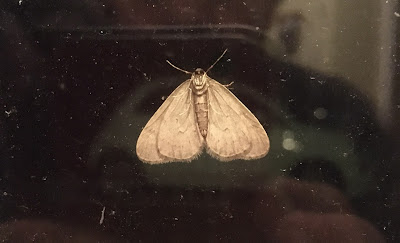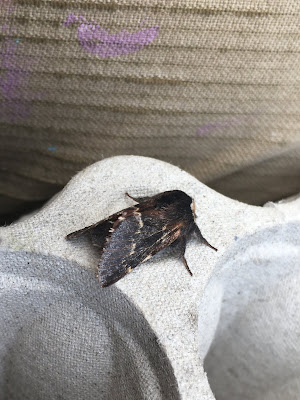Thursday 10 December 2020
A new moth trap
Monday 30 November 2020
Lucky 13
A couple of much milder nights have shown that moths may only be around in limited numbers so far as species are concerned but within each species, the guest-list can still be healthy. Yesterday, for example, no fewer than 13 December Moths paid me a call, nine inside the light-trap and four on the wall of the house nearby.
Here they are in various poses, one of them displaying the fine 'TV aerial' antennae which are as much a feature of the species as its lovely fur coat. Usually moths unfold their antennae when I tickle or otherwise disturb them, but this chap was already on the qui vive.
Meanwhile, our porch light is acting as a minor moth trap, particularly where Winter Moths are concerned. Checking outside lights is always an interesting diversion which anyone can do, as Conehead notes in commenting on my last post. A useful extra is when a window is involved, as you can photograph the moth from both sides (provided your windows are reasonably clean).
My last moths are a pair of Winters, this time on the wall along with the quartet of Decembers.
Elsewhere in the natural world, our many squirrels are foraging energetically at the moment; and we used up our last nasturtium flowers by stuffing them with goats' cheese, anchovy essence and capers. Yum!
Tuesday 24 November 2020
Brrr!
It's difficult to entice moths out when conditions are as chilly as those shown above. But there are still some hardy souls flying about. December moths continue to arrive in good numbers and it was great to get the fine Mottled Umber, below, in spite of the frost.
But things are definitely winding down now. Probably just Winter moths to come. Talking of which, I think that we have one of those here, below, seen from above and below through the transparent cowl.
Saturday 21 November 2020
Every which way
The Red-green Carpets continue to come to the trap in good numbers and this morning they presented themselves from every angle. At the top is one with its body curved to hoick up the tail - a typical resting position for many smaller UK moths. Whether it was trying to attract a mate on a damp and chilly night, I doubt. But moths seem happy to couple at uncomfortably low temperatures.
By contrast, the RGC in the second picture is pretending to be a butterfly, a stance which it refused to alter in spite of being buffeted by lively winds this morning. And finally, below, here is the moth from above; small but full of variety in both pattern and colour.
Wednesday 18 November 2020
A mild mixture
The damp weather is a bit of a frustration at the moment but the compensation, on nights which stay dry as happened yesterday, is that the temperatures are pleasantly mild. Moth numbers are reasonably good as a result, and the variety is welcome at a time of year when fewer species are usually about.
This morning saw three Red-green Carpets, for example, two on the house wall near the trap and one in an eggbox which hoisted its wings into 'butterfly mode' when I clumsily knocked the box while fishing out another one. It then transferred to the bulbholder and was still there an hour later, now with its wings in the usual, flatback position.
There were also two examples of that lovely moth, the raked-wing Angle Shades which flies all year round although usually in smaller numbers over the winter. And the trap's transparent cowl hosted a nice, fresh Mottled Umber with its russety Autumnal colouring.
A December moth in the eggboxes and a Silver Y down at the bottom of the wall near the grass rounded things off nicely; a good collection for one night so late in the year.
Saturday 14 November 2020
Tufty - or Lizard
Do you remember Tufty the red squirrel which fronted the various campaigns of the Royal Society for the Prevention of Accidents? Here is his moth equivalent, a scrap of a micro called Acleris cristana which looks pretty ordinary until you see it sideways on.

Wednesday 11 November 2020
Scarcely scarce
Tuesday 10 November 2020
Cuddly latecomer
One of the last moths in the usual calendar has called for two nights running in spite of misty moisty weather. The December Moth is a fitting companion for the Sprawler as it has the same excellent taste in furry collars and handsome wing patterning.
it is one of the Eggar moths who come early on in the Moth Bible because of their relatively primitive structure which includes the inability to feed. They tend to huddle close but one of my arrivals had dislocated its hindwing, which operates on an interesting coupling which is one of the indicators when seeking the difference between butterflies and moths. These can be relocated but I am too clumsy and was worried that I might do further damage. Let's hope the problem sorted itself out.
It did give me, and now you, a glimpse of the usually-hidden wing which follows the dark and cream pattern of the moth overall. The combination reminds me of the classy old Pullman trains which used to operate in the UK and can now be examined in various museums.
I am shining the light occasionally still, because other enthusiasts round here, especially in Buckinghamshire, are reporting very interesting visitors to their traps. I doubt that I will be so luckly this far further North, but the December moths' companions, though few, have been attractive: Green-brindled Crescent, Sprawler and that gutsy all-the-year-rounder, the Silver Y.






















































